"Target your audience."
That's got to be one of the most overused tropes in the marketing industry. It also just so happens to be an extremely critical aspect of ensuring your digital marketing efforts are successful. Sometimes tropes are true.
On one level, targeting your audience is simple. Someone searching for motorcycle batteries shouldn't be driven to a page selling car batteries. Though both audiences are looking for batteries, those are two entirely different needs. But there's another important aspect of audience targeting that often gets overlooked. When targeting searchers, you want them to land on a page that not only represents what they are searching for, but also a page that best represents the intent of the query.
How searcher intent fits in with the buying cycle
There is a lot of this going around so feel free to skip down a bit if you've heard it before, but there are four basic searcher intents:
- Investigational – A query that aims to learn more about a product or service, usually with the intent to make a future purchase.
- Informational – A query that’s broad and aims at general information. Searchers are typically looking for content that isn't sales in nature, but is more educational.
- Transactional – A query that’s designed to lead the searcher to a sale. These queries are typically more specific in nature to produce the most accurate set of results possible.
- Navigational – A query in which the visitor wishes to land on a specific site. These almost always include the brand name of the site in question.
Each of these search intents fits somewhere in the buying cycle and will produce varying degrees of traffic and conversion rates. Informational and Investigational searches produce the most traffic, Investigational and Transactional searches produce the largest new customers. Navigational and Transactional searches have lower traffic volume but the highest conversion rates.
If you offer products and services for sale, the above information is only the first layer of understanding searcher intent. You now have to factor in the buying cycle, which consists of four phases:
- Informational Phase - A good portion of these searchers are not going to lead to a sale. They are usually comprised of do-it-yourselfers. But, with enough branding, combined with the searcher's own frustrations, these can turn into eventual customers.
- Research Phase - The searcher is in the early stages of the cycle, learning more about what they want and need.
- Shopping Phase - The searcher now has a good idea of what they are looking for and are now learning about the finer details: features, benefits, value-proofs, etc.
- Buying Phase – The visitor knows almost exactly what they want to buy and are now looking to see who has the options they want along with the credibility as a provider.
Putting all this together, you get something that looks like this:
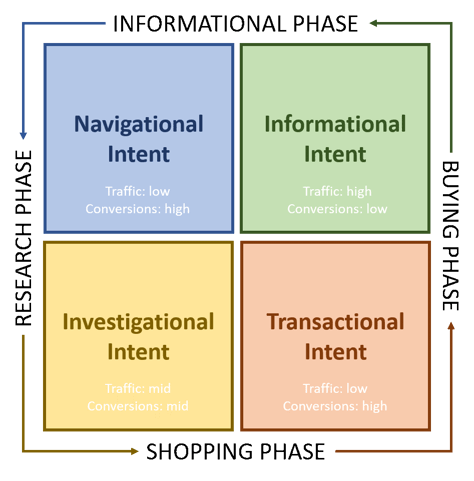
That's the easy part! The more difficult task is determining where any particular phrase falls within the shopping/intent spectrum. That's not always easy to discern but is foundational to being able to Reach, Deliver, Satisfy, and Convert your audience.
Reach your audience where they are
Keyword research is about more than discovering keywords. It's about understanding them. It's about understanding what information the searcher actually wants as a result of their search.
In the chart below, I did some research for the term motorcycle battery. Obviously, this doesn't represent everything I found, but I used a small sampling and then organized them by intent. I know it's easy to ignore details when looking at graphics like the one below, but the keywords themselves are important to understanding how and why they are categorized as they are.
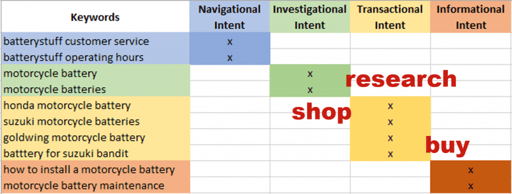
How searcher intent fits in with the buying cycle
Once you have an understanding of what customers want based on what they searched, the next step is to make sure they find the content that best fulfills the intent of their query.
If your site was built correctly, you should already have (most of) the pages necessary for the highest volume queries. The following pages of your site should be ready-made to handle most searcher intents. Keep in mind, if you don't have all the pages you need for all your keywords, you can always add content later.
- Product Category Pages - These pages share broad information, such as the types of products that are available. Visitors need this information when they are beginning to research a future purchase.
- Sub-Category Pages - These pages include information that appeals to shoppers who have a general idea of what they want but aren’t sure which specific product to buy.
- Product Pages - Shoppers in the buying stage know exactly what product they want and are determining where to make the transaction. These visitors tend to type the product name directly into search. You want to bring them to a page that specifically talks about that product alone and gives them the information they need to decide that your company is the best place to make the purchase.
The three pages above break down as follows in the sales cycle:
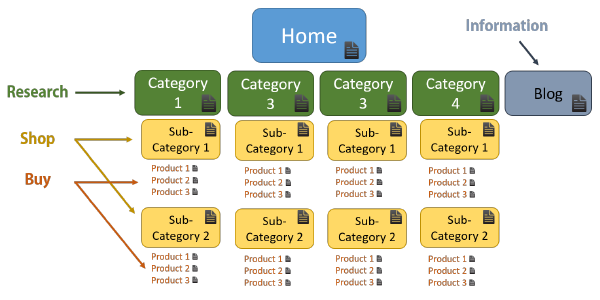
Or, if you prefer, how they break down based on query type:
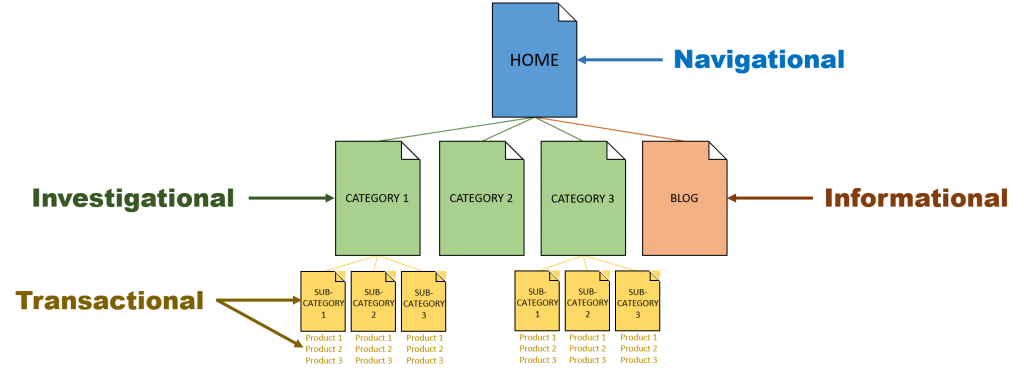
These are not perfect page-type categorizations that work 100% of the time, but this will likely cover 90% of all queries.
Satisfy searchers with the content they seek
The best page for a potential customer to land on is the page that most closely satisfies the intent of their search. As noted above, there are certain pages that align with where searchers are in the buying cycle, but it's not just the page that matters. The content on the page is crucial as well.
When searchers are in the early stages of the buying cycle, the content of the page shouldn't be trying to close the deal. Instead, it should be used to introduce the reader to your company, your product, and/or the value of what you offer overall. Only when visitors get to the later stage of the cycle should you actually try to solicit the conversion.
Similarly, if the customer is ready to make a purchase and the search brings them to an overview type page, there's a good chance of losing them. Not only is this not the content they are looking for, but they will also be forced to navigate around your site in order to find the page where their intent is fulfilled.
Some will navigate around. Others will leave.
Find Your Pages’ Special Purpose
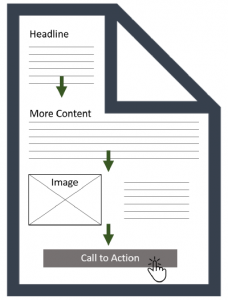
Every page has a unique purpose, and it's your job to ensure it has the content to match. That could be a little or a lot. It doesn't matter. What does matter is that it's just the right amount of content to give the visitor what they need. No more, no less.
When a visitor comes to your page, they typically start at the top. The content needs to move them further down the page – compel them to read more. The content that follows should do the same until finally, the visitor is presented with an opportunity to take an action.
If at any point the content does not compel the visitor to move to the next section of content on the page, then it's not fulfilling the visitor's intent.
Convert searchers into customers
Just as every page has a purpose, every page should also have an answer to the question, “What’s next?”
Getting visitors to the page isn't the goal. Having visitors read the content isn't the goal. Compelling visitors to take an action is the goal. But if you don't make that action clear, it’s a mission failure.
Every page needs one primary call-to-action (CTA) and can benefit from one or two supporting actions. What the primary action should be is dependent on the intent:
- Researcher - Move visitor from the researching phase to the shopping phase.
- Shopper - Move visitor from the shopping phase to the buying phase.
- Buyer - Move visitor from the buying phase to make a purchase
These primary actions should be the most obvious action on the page. Don't leave the shopper to guess what action to take next.
But, not every shopper is ready for the next big step, which is where supporting actions take place. Use those to keep visitors engaged with your site, and again, lead them to content that helps propel them to the next phase of the cycle.
Not All Customers Are Alike
Just as with personal differences, customers are also separated by differences in motivation. That means two customers looking for the same thing may have different reasons why, levels of urgency, and where they fall in the buying cycle.
As the seller or service provider, it's up to you to help guide the shopper on their journey. The better job you do of giving them exactly what they want and then guiding them through the conclusion of their journey, the better chance you'll have of securing the sale. Taking the lazy way and forcing the shopper to do all the work will often leave you shopperless.
When keyword intent, landing page, content, and calls-to-action all complement each other, it makes it easier for site visitors to get what they need. If they get what they need from you, they'll buy. If not, they'll still buy - just from someone else.
Ready to move your audience through the buyers cycle? We can help.



